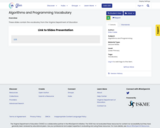
These slides contain the vocabulary from the Virginia Department of Education
- Subject:
- Algorithms and Programming
- Material Type:
- Lecture Notes
- Author:
- Erika Coble
- Date Added:
- 06/26/2022

These slides contain the vocabulary from the Virginia Department of Education
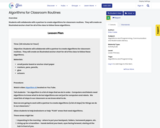
Students will collaborate with a partner to create algorithms for classroom routines. They will create an illustrated anchor chart for all of the class to follow these algorithms.

Students determine if a design solution works as intended to change the speed or direction of an object with a push or pull by designing and creating a ramp. They test their design, make improvements and redesign their ramp before retesting. They graph their data to determine which ramp makes their ball hit their intended target.

This is a unit plan to teach computational thinking in the primary grades.

This game is played the same way you would play hopscotch.
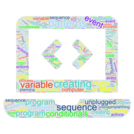
This is a list of basic vocabulary with definitions and/or examples that will be used in elementary classrooms K-5 when teaching the concepts of algorithms and programming.

Students will be introduced to the term algorithm while reading the story of Humpty Dumpty. Students will develop an algorithm or step by step sequence of instructions for putting Humpty Dumpty back together again.

Students will love and enjoy this lesson based from the popular book, If You Give a Mouse a Cookie by Laura Numeroff . Within this lesson, students learn the concept of sequencing and will practice this process as they practice arranging the events of the story in sequential order. Students will also practice their ability to retell a story.
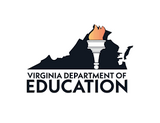
This lesson can be taught during a science lesson, as it relates to Science K.7b. It also relates to other core curriculum (English K.8e beginning, middle, and end; Science K.1 observing and investigating; Math K.13 patterns; K.9 patterns in nature; History K.1c sequencing events) and could be modified and integrated there, as well.

Create a 3D Butterfly life cycle model with this activity!

This activity supports student knowledge of community and story telling. Students also build map skills and coding skills as they use the robot to act out the story. Basic block coding skills can be taught as part of the lesson or prior to the lesson.

Students get a hands-on approach to carving a pumpkin while learning about the life cycle. Students will sort pictures of a pumpkin life cycle, create a paper plate pumpkin, and manipulate pumpkin seeds for counting and sorting.

Let’s bake a fall treat for your littles to eat! This activity supports step-by-step instructions using sequential graphic organizers and will use their five senses to find, take in, and react to or respond to different information.

“Just when the caterpillar thought the world was over, it became a butterfly”. - Old English ProverbStudents will observe the world of the butterfly through hands-on activities and learn about its amazing journey from a tiny egg to a beautiful butterfly. Your students will investigate and understand the sequential order of the butterfly’s life cycle.
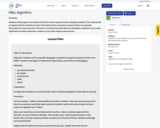
Students will program the teacher (robot) to make a peanut butter and jelly sandwich. This will provide an opportunity for students to learn that robots (and computers) need to follow very specific instructions to work correctly. This lesson could then be extended into letting the students try to create algorithms for daily classroom routines or any other step by step process.
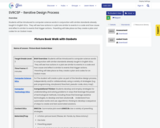
Students will be introduced to computer science words in conjunction with similar standards already taught in English SOLs. They will see how actions in a plot are similar to events in a code and how cause and effect is similar to events that trigger actions. Prewriting will take place as they create a plan and codes for an Ozobot maze.
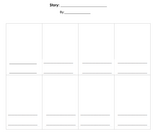
Students will love and enjoy this lesson based from the popular book, Bad Kitty by Nick Bruel. Within this lesson, students learn the concept of sequencing and storyboards. They will learn the importance of a storyboard by looking at the example in Bad Kitty. Students will show their understanding as they create their own storyboard about an animal of their choice.